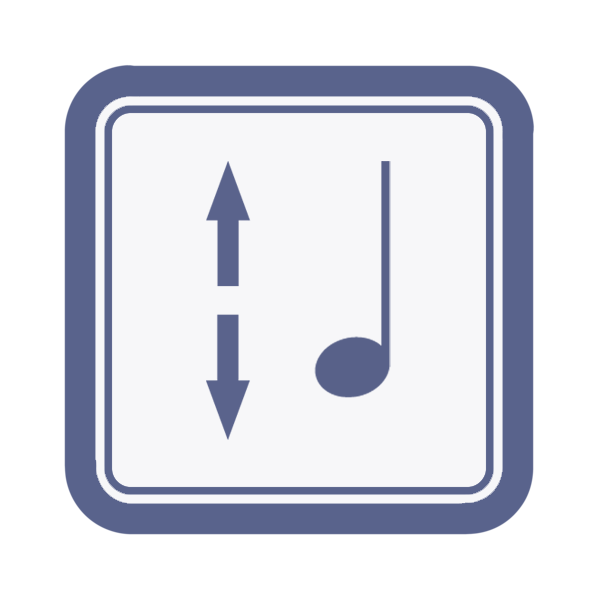Last week I received a question from someone who’d been using our ear training exercises and felt frustrated that they weren’t making faster progress. In fact, they’d reached the point of despair, wondering if it was actually even possible for them to learn intervals.
They said:
I’m starting to suspect that I have a brain that simply cannot comprehend the distance between notes, no matter how hard or for how long I try.
Have you ever encountered anybody with “music dyslexia?” Is there such a thing?
Maybe you can relate to this. There are probably areas of your own musical training where you’ve wondered “do I have what it takes to learn this?”
It’s a question I’ve heard a lot over the years, in different forms.
“Is ear training even possible for me?”
“Are my ears broken?”
“Maybe I’m just not musical”
I certainly know that feeling. When I was learning music at school I would ask myself this kind of question often. The self-doubt returned later on when I began doing ear training.
Since then I’ve been blessed with the opportunity to help thousands of email subscribers and hundreds of members inside Musical U with their ear training, so I can tell you with confidence: you are not alone in wondering this!
I can also tell you: Yes, you can do it.
Now I know you’re probably thinking “How do you know? My situation is different. Maybe I actually am musically handicapped.”
Please keep reading.
I’m going to specifically discuss the question of interval ear training – but most of what we’ll be talking about applies more broadly to all areas of musicality training.
Pitch, Tone Deafness and Intervals
 Intervals are an area many musicians start with when first exploring ear training, but intervals themselves aren’t all that interesting. They’re really just a means to an end.
Intervals are an area many musicians start with when first exploring ear training, but intervals themselves aren’t all that interesting. They’re really just a means to an end.
The real goal is: I want to recognise notes by ear when I hear them.
Normally this is driven by a desire to play by ear, improvise, or simply to understand instinctively how the music we love actually works and moves us so powerfully.
Learning interval recognition is about training your ears to distinguish different distances in pitch: how far away is one note from another.
This means that there are two other issues at play when it comes to interval ear training.
1: Perfect Pitch
The first is confusion about perfect pitch. It’s a topic surrounded by myths and misunderstandings. For example: Having perfect pitch is not about being perfectly accurate about pitch or being able to sing “pitch perfect”!
For me personally a large part of why I initially struggled with intervals was because I was simultaneously trying to do ear training for perfect pitch.
Getting perfect pitch is possible – but it’s very difficult to learn as an adult, and you’re much better off focusing on relative pitch i.e. intervals. I learned this the hard way! If I hadn’t been chasing the unicorn of perfect pitch I would have made much faster progress towards my goal of playing music by ear.
2: Tone Deafness

The second issue at play is pitch itself. Can you reliably hear the pitch of a note? Even quite experienced musicians worry that their pitch skills are insufficient, for example when it comes to tuning their instrument by ear. Another major issue is thinking that because you can’t sing in tune you must be tone deaf.
If you’ve been struggling to learn intervals then first put aside the distractions of perfect pitch and worrying about tone deafness.
You might be wondering how we can be confident putting aside worries about tone deafness…
You are not tone deaf
 I’ve never met you but I’m going to assume you love music. You have favourite bands, you enjoy listening to music for pleasure, maybe you’ve even learned to play an instrument or sing.
I’ve never met you but I’m going to assume you love music. You have favourite bands, you enjoy listening to music for pleasure, maybe you’ve even learned to play an instrument or sing.
Right?
If so, then I can tell you: You are not tone deaf.
There is a real clinical condition of tone deafness. However, if you were truly tone deaf you could not enjoy music. Still not convinced? Prove it one way or the other in 3 minutes with a tone deaf test.
So what you really have is untrained ears.
You haven’t yet learned the pitch judging skills required to recognise intervals, play by ear, improvise, and so on.
You might also have an untrained voice so that you sing out of tune – if that’s the case check out our free guide to learn to sing in tune.
Why you are struggling with intervals

So if you’re not fundamentally incapable of learning this skill, why have you been finding interval ear training so hard?
There are two possibilities. Either your expectations are wrong or you’re doing interval ear training wrong. Let’s dig into each of these.
Are you expecting too much too soon?
The idea of ear training is exciting. I remember when I first discovered that there was actually a method to learn those seemingly-magic skills of musicality like playing by ear and improvising. Amazing!
All I needed to do was some of this “ear training” and I’d be one of those natural musicians.
Unfortunately, ear training is not a magic wand.
Like all worthwhile abilities, listening skills take time and effort to learn. Ear training is a process and a practice. If done right it consistently delivers valuable steps forward over time, but true mastery (the effortless freedom to play anything you want by ear, for example) is going to take months or even years to obtain.
So if you’re frustrated learning intervals, first ask yourself: are your expectations reasonable?
How long does ear training take? The short answer is: it depends.
It depends on your musical background, your existing abilities, your exact goals, the amount you practice and (perhaps most importantly) doing it right – more on this below.
So there’s no single answer I can give you about what reasonable expectations are for you.
Here’s what I can tell you: if you’ve been doing this for less than a few months and expected to have “finished” ear training by then, that’s not realistic.
That said, ear training (when done right) should give you steady signs of improvement. That means that if you’ve been working on the same thing for more than a week with no signs of progress, then it’s time to make a change.
Are you doing it wrong?
Ear training results don’t happen overnight but small steps forward should be happening regularly.
If you’re not expecting perfection, just signs of improvement, and you’re frustrated that you’re not seeing them – you should be! Something is not right about the way you’re training.
Please don’t feel insulted by that, or in any way guilty. Doing it wrong is unfortunately incredibly common.
It happens for two quite different reasons. One is avoidable – and the other is fixable.
Do you have what you need?

The first way musicians are “doing it wrong” is that they just aren’t equipped to learn intervals.
This might mean they skipped learning how to learn intervals and just dived right in blindly.
It might mean they bought a particular course or app that seemed good – but isn’t actually grounded in proven methods with a sensible progression of lessons.
Or it might mean they’ve been jumping from resource to resource, reading an article here, watching a YouTube video there, dabbling in three different apps and half-heartedly doing some instrument exercises. Pulled in all directions it’s no wonder their brain and ears can’t figure out what they’re meant to be learning!
In all these cases, the solution is clear: Pick one proven solution for interval ear training, developed by experts, and stick with it. This gives you your best chance of success with training.
Still, things can go off track – and that’s the other way you might be “doing it wrong”…
Is it time for a change?
As mentioned above, every musician is different when it comes to ear training. That means that there cannot be a best ear training method. The best method is the one that works best for you.
Specifically, there can be no “one size fits all” course for learning intervals. Oh you will find them for sale. Lessons, courses, books and apps. But the chances of you being able to follow one of them start to finish and emerge having mastered intervals? Slim to none. And that’s not your fault!
The reality is that ear training is a journey, and not one where you can pick a direction, close your eyes, and move straight forwards. It’s more like an airplane or boat being blown by the wind, or a car coping with diversions due to roadworks and traffic. You need to keep checking the map and adjusting course if you want to reach your destination.
Ear training course corrections
So how do you fix this problem? How do you do this kind of training that’s personalised to you and capable of being adjusted along the way?
You need a system of musicality training that provides not only the high quality training resources you need, but a flexible system for using those resources in a way that matches your background and goals, and can be adjusted when your progress slows or stalls. And (perhaps more importantly) you need to abandon the idea that ear training is something you can do successfully in isolation.
The truth is that every musician will struggle at some point in their journey. Even with high quality resources and a flexible way to use them, you may not know the right changes to make when you start to struggle. The solution is to have access to expert help to guide you in making suitable adjustments to your training plan, and some emotional support – because it really can be frustrating and discouraging when you’re not seeing the progress you hoped for.
Of course this can also help a huge amount with making sure your expectations are reasonable and you have a sensible plan to start from.

It’s no coincidence that this is how we’ve set things up at Musical U. Through our experience trying the “one size fits all” approach and coaching large numbers of musicians through making training adjustments and finding their own way to success, we realised there was the opportunity to build a flexible training system coupled with a supportive community and access to unlimited personal expert help.
 Inside Musical U you’ll find a clear Roadmap for learning to play by ear using intervals and several interval training modules providing a variety of methods for interval ear training which can be used as part of the flexible training system.
Inside Musical U you’ll find a clear Roadmap for learning to play by ear using intervals and several interval training modules providing a variety of methods for interval ear training which can be used as part of the flexible training system.
This material has already helped thousands of musicians to master interval recognition – and if it doesn’t seem to be working for you, the team is available every day to help with questions and provide guidance on how you can continue to make progress.
Why you’ve struggled with intervals
Let’s recap. First of all, it’s normal to be struggling with musicality training, so don’t feel too discouraged from your goal. If you love listening to music then you are fundamentally capable of learning these skills.
If you’re not seeing the progress you expected, check if your expectations are reasonable. If so, ask yourself whether you have selected a single proven solution for interval ear training. If you have chosen a good solution and your progress has stalled, you probably need to make an adjustment to your training. The most effective way to do that will be with some advice from a music mentor or ear training coach.
So don’t worry if you’ve struggled with intervals. You’re certainly not alone, and it will be possible for you to learn. Just make the changes recommended above and you’ll soon be making clear progress towards that goal!








